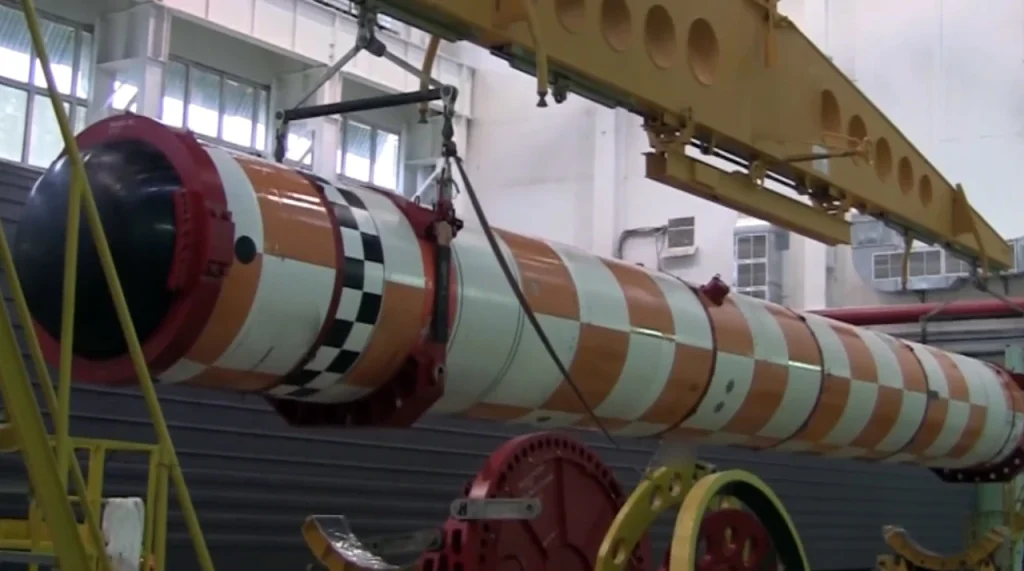The special-purpose nuclear submarine BS-329 Belgorod of project 09852, which joined the Russian fleet in July and is the newest nuclear submarine, seems to be a big threat to the United States.
No Equivalents
The Main Directorate for Deep Sea Research (GUGI) of the Russian Ministry of Defense tasked the Rubin Central Design Bureau to build the Belgorod submarine. It was then built in Severodvinsk by the Sevmash Production Association. It is believed that today Belgorod is not only one of the most unusual submarines, but also the world’s largest combat submarine. It is 184 metres long, 12 metres longer than Project 941 Typhoon’s biggest submarine missile carriers. But what makes Belgorod special is not its size but equipment and purpose.
Everyone remembers the 2M39 Poseidon complex, a unique underwater weapon system first communicated in the president’s speech to the Federal Assembly on March 1, 2018. It is called a giant thermonuclear torpedo. Poseidon is a robotic system that works across continents. It has a nuclear power plant. And it’s more than just a torpedo. It’s a self-driving underwater vehicle that can follow a complicated programme for months or even years at almost any depth and thousands of kilometres away from Russia’s territorial waters.
The combat system’s primary objective is to ensure that large coastal and sea targets, like squadrons of ships, naval bases, coastal territories, and megacities, can be destroyed with powerful thermonuclear warheads.
In a way, a megaton charge exploding in coastal waters could make a new Panama Canal in the place of impact. At the same time, Poseidons can be on combat duty for years at the bottom of the ocean, waiting for an order. They can also be used on targets from special submarines that carry them.

The submarines of project 09851 “Khabarovsk,” currently being built at the Sevmash Production Association, are expected to be the combat carriers of the future weapons system. Six Poseidon launchers will be on each of them. But before the Khabarovsk and its more minor brothers can join the fleet, the weapon system must be tested, the crew must learn how to use it, and it must be turned from a high-tech prototype into a real weapon. The BS-329 Belgorod, a special-purpose boat that will be the first test carrier for the 2M39 Poseidon underwater complex, is intended to do these jobs.
The Ministry of Defense signed a contract in 2012 to build a project 09852 experimental submarine. As a starting point, they used the unfinished hull of the Belgorod project 949A submarine, which was left in Severodvinsk along with the other unfinished “aircraft carrier killers.” In the 1990s, work on several boats for that project was put on hold. The ship’s hull was modified a lot to meet the needs of its advanced weapons systems and the equipment needed. Belgorod is different because it is not only made for Poseidon but also for deep-sea crewed and unmanned underwater vehicles that can operate on their own.
“Belgorod” is a unique underwater platform that lets scientists research in remote parts of the ocean, install different kinds of underwater equipment, and check on and replace underwater systems that have already been put in place. Most importantly, there is a special docking compartment for deep-sea nuclear stations under the bottom of the Belgorod. These are a type of submarines that is only in the Russian fleet and can perform missions at almost any depth in the area where they are delivered by large carrier boats.
Multipurpose submarine
In the absence of information, one can only imagine what the Belgorod, an underwater cruiser, might be able to do. Here are some of the possibilities listed by the Russian media.
- Testing and using “Poseidon” underwater combat drones anywhere in the oceans.
- Special small uncrewed vehicles are used to take care of the Poseidon near the bottom of the service mode.
- The operation of an autonomous underwater attack warning system based in the ocean could, in theory, be set up on the Russian continental shelf. The parts of such a system will need to be set up and taken care of, and the energy sources will need to be kept up to date. And “Belgorod” with its drones will be a must-have in this situation.
- The possibility of using a deep-sea nuclear station will also make it possible for Belgorod to do special missions on the ocean floor, such as research or surveillance.
On December 20, 2012, the unfinished submarine K-329 Belgorod was moved to shop No. 55 of the Sevmash Production Association in Severodvinsk as part of project 09852. This was the first step in making the world’s first underwater carrier of combat drones. In April 2019, the boat was taken out of the workshop and put on the water so it could be finished and tested. On June 25, 2021, just over a year ago, Belgorod left Severodvinsk for the first time to go on sea trials in the White Sea. And finally, on July 8, 2022, the special boat was given to the fleet. Until then, the main weapons complex had not been tested with the Poseidon uncrewed nuclear submarine.
Now, “Belgorod” will be used to test “Poseidon’s” so they can figure out how to move, launch, control, and guide it. The Poseidons will, of course, be able to carry a powerful thermonuclear warhead, but they will also be able to learn to do many peaceful things, like surveillance, monitoring, scientific observations, and cargo transport. But so far, we only know how the military can use a new type of underwater system. As a nuclear weapon system, “Poseidon’s” will be tested on “Belgorod,” and later, it will be used on “Khabarovsk”-type boats.
We know that the Khabarovsk boats will be part of the Northern and Pacific Fleets. The combat system is too new and complicated to be put into service before the test programme is over. Most likely, these tests will take between three and five years.
